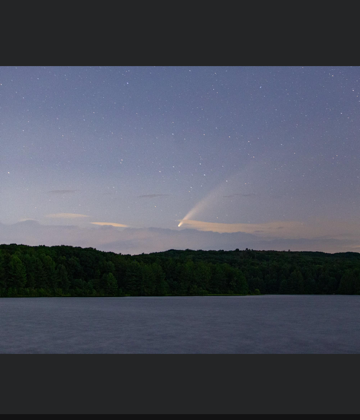Discovery of a New Comet
By Matthew Johnson
The discovery of Comet NEOWISE proved to be astonishing, especially to those who hunt for such objects. It surprised astronomers when it passed by the Sun emitting a bright tail as well as a darker dust tail.
The comet was discovered March 27 by NASA’s Near-Earth Object Wide-Field InfraredSurvey Explorer. This space telescope is designed to study asteroids that orbit close to the Earth by scanning the entire sky. Focused on single objects, it was able to locate Comet NEOWISE’s small three-mile-wide nucleus as the comet made its way around the Sun and back out into deep space. It is not scheduled to return for 6,800 years.
Comets are usually discovered by astronomers both professional and amateur, and the discoverers are allowed to attach their own name to the object. Since a NASA probe discovered it instead of a human, this comet was named after the probe. NEOWISE is an acronym of Near-Earth Object Wide-Field Infrared Survey Explorer.
This comet is the brightest since Hale-Bopp in 1995. Although it is dimming quickly, it might still be visible in early August, although a pair of binoculars might be required depending on how quickly it fades from naked-eye view. NEOWISE can be located in the north to northwest just below the bucket of the Big Dipper,making it is easy to find from any dark site in Norfolk.
Other celestial events:
Full Moon: Aug. 3
This full moon was known by early Native American tribes as the Sturgeon Moon because the large sturgeon fish of the Great Lakes were more easily caught at this time of year. This moon has also been known as the Green Corn Moon and the Grain Moon.
Aug. 11-12
The Perseid meteor shower is one of the best meteor showers to observe. At its peak, it has been known to display as many as 60 meteors per hour. As you might know from viewing Comet NEOWISE, as the comet neared the Sun it began to display a tail. The tail is composed of ionized atoms and other compounds that evaporated from the comet’s surface as the comet’s orbit drew it nearer and nearer to the Sun’s intense energy. Comets leave these particles behind as they travel through our solar system. It is the tiny space debris from Comet Swift-Tuttle that produces the Perseids. The Perseids are named after the constellation Perseus because the direction from which the shower seems to appear in the sky, its radiant, lies within Perseus.
I will ask the park rangers for the key to the gate at Dennis Hill State Park the night of Aug. 11 so that we can observe the Perseid meteor shower the entire night of Aug. 11-12. If the rangers agree to this, I will post a large sign at the bottom of Dennis Hill. Bring along a pino.
Aug. 13, Venus at Greatest Elongation
The planet Venus reaches greatest western elongation of 45.8 degrees from the Sun. This is the best time to view Venus since it will be at its highest point above the horizon in the morning sky. Look for the bright planet in the eastern sky before sunrise.
Aug. 19, New Moon or no visible moon.
This is the best time of the month to observe faint objects such as galaxies and star clusters because there is no moonlight to interfere. Jupiter leads Saturn across the ecliptic in August. Both are visible all night long, presenting a glorious apparition. Saturn’s rings remain tilted for the finest viewing in August. Russet-red Mars follows Jupiter and Saturn. All three can be seen by the naked eye, although use of binoculars reveals four of Jupiter’s moons and reveals Saturn.

